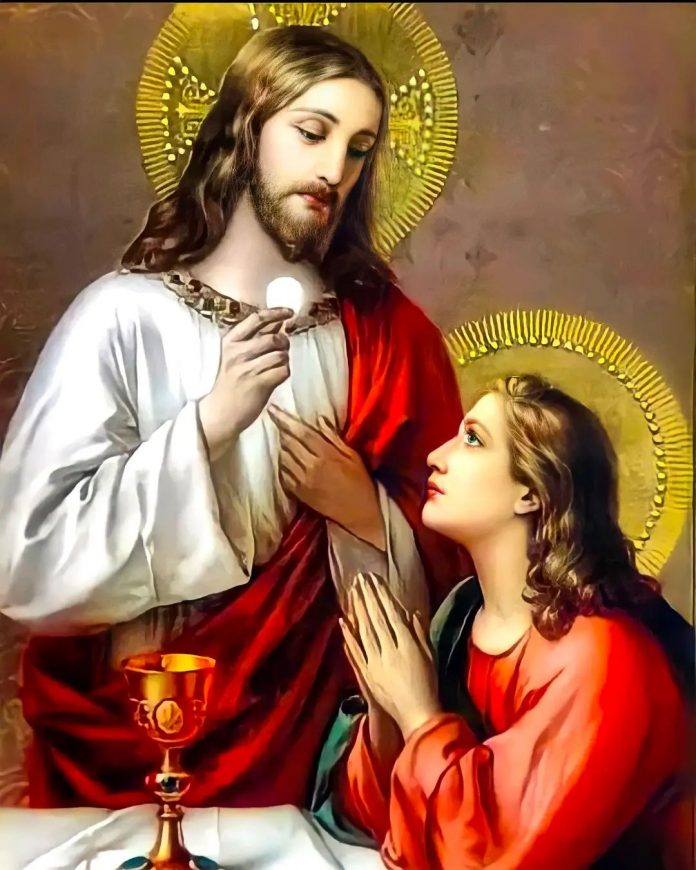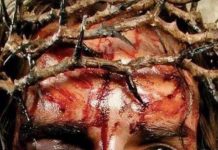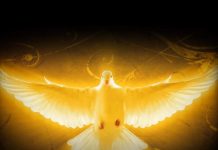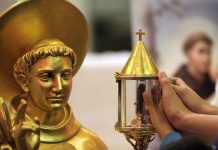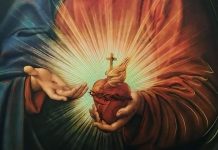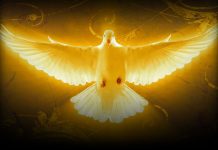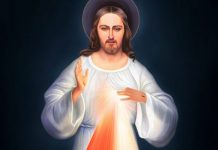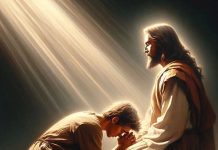What is the Holy Eucharist?
The word “Eucharist” means “thanksgiving” and “to show favor.”
The Eucharist is the Body, Blood, Soul, and Divinity of Our Lord Jesus Christ, that united in His one Divine Person is really, truly, and substantially present. This is the summation of twenty centuries of doctrine and Tradition of Scripture, the Church Doctors and theologians, Papal Encyclicals, and Councils of the Catholic Church.
Who is the Eucharist?
The “who” of the Eucharist is derived from the “what” of the Eucharist.
Who is personally present in the Holy Eucharist? It is the Second Divine Person of the Most Holy Trinity, the God-Man Jesus Christ. Present to us through Jesus Christ in the Eucharist are also God the Father and God the Holy Spirit. Therefore, in virtue of Jesus’ Real Presence, we can also say that the entire Holy Trinity is really present to us.
In the Holy Eucharist, the Holy Trinity is really present to us in three ways: present personally in being, present in time in the present “now,” and present to us in love.
Why the Eucharist?
To ask “why” is to ask the purpose. What is the purpose of the Eucharist? One may ask, “What is the Divine purpose or reason for giving us the Holy Eucharist?” The Eucharist is the God-food of the God-Man; It makes us God-bearers who are God-empowered to do what is humanly impossible but supernaturally possible with God’s Eucharistic grace. “To do what?” one might ask. The Eucharist personally and supernaturally transforms us in order that we may transform our families, our nation, our Church, the world, and the entire human race in order to achieve their eternal salvation.
This is why the Church says that the Eucharist is the “source and summit” of the Faith.
The Catechism of the Catholic Church, paragraph 1324, states: “The Eucharist is the source and the summit of the Christian life (LG 11). The other sacraments, and indeed all ecclesiastical ministries and works of the apostolate, are bound up with and are oriented toward it. For in the Blessed Sacrament is contained the whole spiritual good of the Church; namely Christ Himself, our Pasch.”
The Catechism continues in paragraph 1325: “The Eucharist is the efficacious sign and sublime cause of that communion in the divine life and that unity of the People of God by which the Church is kept in being. It is the culmination both of God’s action sanctifying the world in Christ and of the worship men offer to Christ and through Him to the Father in the Holy Spirit.”
Finally, the Catechism concludes in paragraph 1327: “In brief, the Eucharist is the sum and summary of our faith. ‘Our way of thinking is attuned to the Eucharist, and the Eucharist in turn confirms our way of thinking’ (St. Irenaeus, Adv. haeres, 4,18,5:PG 7/l,1028).”
Our Lord Jesus Christ gave us the Holy Eucharist on Holy Thursday night for our salvation and to continue, through His Body and Blood, to apply the outflow of His saving grace won on the Cross until the end of time, as St. Paul said, “until He comes again” (1 Cor. 10). Jesus made this abundantly clear in John 6 when he repeatedly said, “He who eats My Flesh and drinks My Blood has eternal life.”
We receive the Eucharist during the Eucharistic celebration (Holy Mass) and adore Jesus in order that we may spend an eternity of happiness with Him in heaven, where we will no longer see Jesus Eucharistically veiled, but “see Him as He is” (St John).
What is the Essence of the Eucharist?
What is the heart and soul of the Eucharist? It is the self-sacrificial love of Jesus Christ. Jesus, by His Crucifixion on Good Friday, finished, brought to completion, His Eucharistic Sacrifice begun the night before at the Last Supper. Therefore, Holy Thursday and Good Friday are one and the same sacrifice–initiation and completion.
The Holy Eucharist As Sacrament
What is a sacrament? A sacrament is a sensible sign instituted by Jesus Christ the God-Man, by which invisible grace and inward sanctification are communicated to the soul.
The Holy Eucharist meets all requirements of a sacrament: The Holy Eucharist is a sensible sign in which the elements, which we call the appearances of bread and wine, sensibly identify the true Body and Blood of Christ. At times, as seen throughout the twenty centuries of the Faith, even the appearances of bread and wine have miraculously manifested Jesus’ Body and Blood in order to sensibly foster faith in believers and non-believers.
The Holy Eucharist was instituted by Jesus Christ the God-Man on Holy Thursday at the Last Supper, when Jesus said, “This is My Body….This is My Blood….Do this in memory of Me.”
From the Baltimore Catechism:
347. What happened when Our Lord said, “This is My Body….This is My Blood”?
When Our Lord said, “This is My Body,” the entire substance of the bread was changed into His Body; and when He said, “This is My Blood,” the entire substance of the wine was changed into His Blood.
348. Did anything of the bread and wine remain after their substance had been changed into Our Lord’s Body and Blood?
After the substance of the bread and wine had been changed into Our Lord’s Body and Blood, there remained only the appearances of bread and wine.
349. What do we mean by the appearances of bread and wine?
By the appearances of bread and wine, we mean their color, taste, weight, shape, and whatever else appears to the senses.
350. What is the change of the entire substance of the bread and wine into the Body and Blood of Christ called?
The change of the entire substance of the bread and wine into the Body and Blood of Christ is called transubstantiation.
351. Is Jesus Christ whole and entire both under the appearances of bread and under the appearances of wine?
Jesus Christ is whole and entire both under the appearances of bread and under the appearances of wine.
Jesus, in instituting the Holy Eucharist, did not say, “This was My Body” or “This will be My Body.” Jesus, the Word of God, used the present tense in order to testify by His own words His Real Eucharistic Presence in the present time.
Jesus also said, “This.” What did Jesus mean by “this”? The word “this” is a demonstrative pronoun. “To demonstrate” in Latin means “to show.” A pronoun grammatically refers to a person, place, or thing. In saying, “This is My Body….This is My Blood….” at the Last Supper, Jesus was “showing” us his one Divine Person in the Holy Eucharist.
Because Jesus is personally and really present in the Holy Eucharist by the infallible testimony of His own Divine Person, who as God is all-good and therefore cannot deceive us and as all-knowing cannot be deceived, we believe in His Real, Eucharistic, Divinely Personal Presence. Jesus, as the Author and Originator of all Sanctifying Grace, sacramentally and personally communicates His Divine grace and sanctification to all the faithful who worthily receive Him without mortal sin.
WHY IS THE HOLY EUCHARIST THE PRIMARY SACRAMENT OF SACRAMENTS FROM WHICH ALL THE OTHER SACRAMENTS DERIVE THEIR ORIGIN, POWER, AND EFFICACY?
The Holy Eucharist is the primary sacrament of sacraments that by definition contain and communicate grace, because It contains the Source and Origin of all grace, the Second Divine Person of the Holy Trinity, Jesus Christ. This is why we can say that from the Holy Eucharist, the other six sacraments derive their origin, power, and efficacy.
THE HOLY EUCHARIST AS SACRIFICE SACRAMENT
What is a true sacrifice? A true sacrifice has two dimensions: First, someone or something very precious and unblemished is offered to God. In the context of the Holy Eucharist, it is the sacrifice of the Lamb of God, Jesus Christ, who takes away the sins of the entire world.
Jesus as true God and true Man had His Sacrifice on the Cross totally accepted by the Father to make complete, full, and definitive satisfaction and reparation for the sins of the entire human race for all time, past, present, and future.
The second dimension of a true sacrifice is the outpouring or oblation of blood. This Jesus did once on the Cross in a bloody manner and continues to do in an unbloody manner through His ordained priests today, until the end of time.
In offering the Last Supper, Jesus as the God-Man offered the Holy Sacrifice of the Mass simultaneously on two levels: as God and man, in time and eternity. Jesus as man offered His sacrifice in time; in virtue of His Divinity, He also offered it for all eternity. Therefore, the Holy Sacrifice of the Mass offered at the Last Supper is efficacious and valid for all eternity and all time as offered now on earth by His priests, His Alter Christi (“other Christs”), ordained to have the power of God in consecrating the Eucharist at Mass.
What was done 2000 years ago at the Last Supper, in virtue of the words originally uttered by the God-Man, Jesus Christ, “This is My Body….This is My Blood….,” now becomes present and real to us in the Holy Eucharist today, as the Catechism of the Catholic Church says. Paragraph 1363 states: “In the sense of Sacred Scripture, the memorial is not merely the recollection of past events, but the proclamation of the mighty works wrought by God for men. In the liturgical celebration of these events, they become in a certain way present and real. This is how Israel understands its liberation from Egypt: Every time Passover is celebrated; the Exodus events are made present to the memory of believers so that they may conform their lives to them.”
In paragraph 1364, the Catechism continues: “In the New Testament, the memorial takes on a new meaning. When the Church celebrates the Eucharist, she commemorates Christ’s Passover, and it is made present: The sacrifice Christ offered once and for all on the Cross remains ever present. As often as the sacrifice of the Cross by which ‘Christ our Pasch has been sacrificed’ is celebrated on the altar, the work of our redemption is carried out.”
Finally, in paragraph 1366 the Catechism addresses the Holy Eucharist and the Mass as the sacrificial memorial and re-presentation of the Cross that continually applies its saving fruits: “The Eucharist is thus a sacrifice because it re-presents (makes present) the sacrifice of the Cross, because it is its memorial and because it applies its fruit. The Council of Trent explained this: “[Christ] our Lord and God was once and for all to offer Himself to God the Father by His death on the altar of the Cross, to accomplish there an everlasting redemption. But because His priesthood was not to end with His death, at the Last Supper, ‘on the night He was betrayed,’ [He wanted] to leave to His beloved spouse, the Church, a visible sacrifice (as the nature of man demands) by which the bloody sacrifice which He was to accomplish once and for all on the cross would be re-presented, its memory perpetuated until the end of the world, and its salutary power be applied to the forgiveness of the sins we daily commit.’”
In offering the Holy Sacrifice of the Mass, a duly authorized priest, in the name of the People of God, offers the God-Man Jesus Christ as Victim, in acknowledgement of God’s supreme sovereignty and dominion, and thus our total dependence on God.
“Every great reform has in some way been linked to the rediscovery of belief in the Lord’s Eucharistic presence among His people” (Pope Benedict XVI, Sacramentum Caritatis, 6).


